Top 25 Texas Butterflies: The Ultimate Guide!
With over 400 butterfly species, Texas has more types of butterflies than any other state! I’ve selected just a subset of butterflies in Texas for this guide.
These 25 species are typically found throughout the state and fly throughout the year. They are some of the most common butterflies you will find in your garden, especially if you grow Texas native plants!
Start by downloading my free printable PDF of 10 Common Texas Butterflies. You this handy one-pager to help identify butterflies you see in your yard.
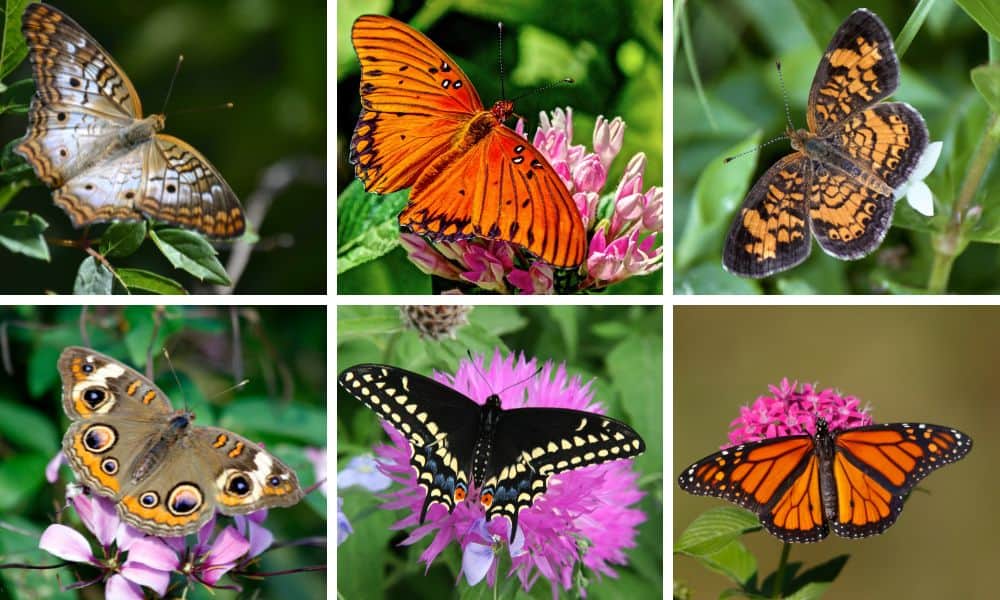
While these butterflies are common in Texas, some can be found throughout the United States. I’ve included both their common names and scientific names (in parentheses), as well as their host plants, below.
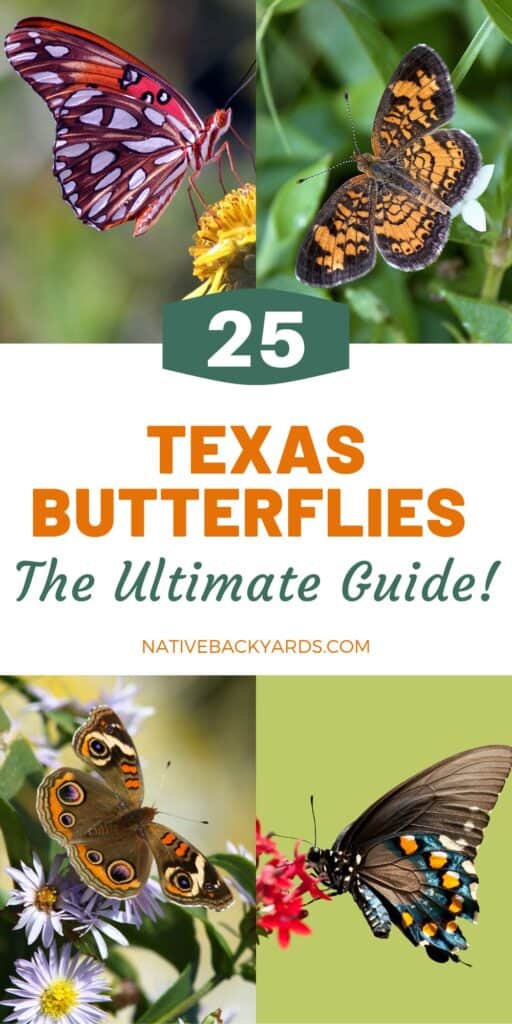
Download the Free PDF: 10 Texas Butterflies
I created a handy one-page PDF for you to print and keep by your backyard patio or in your gardening bag. It includes a thumbnail photo of each butterfly along with tips for identifying them and a list of their host plants. Get it here:
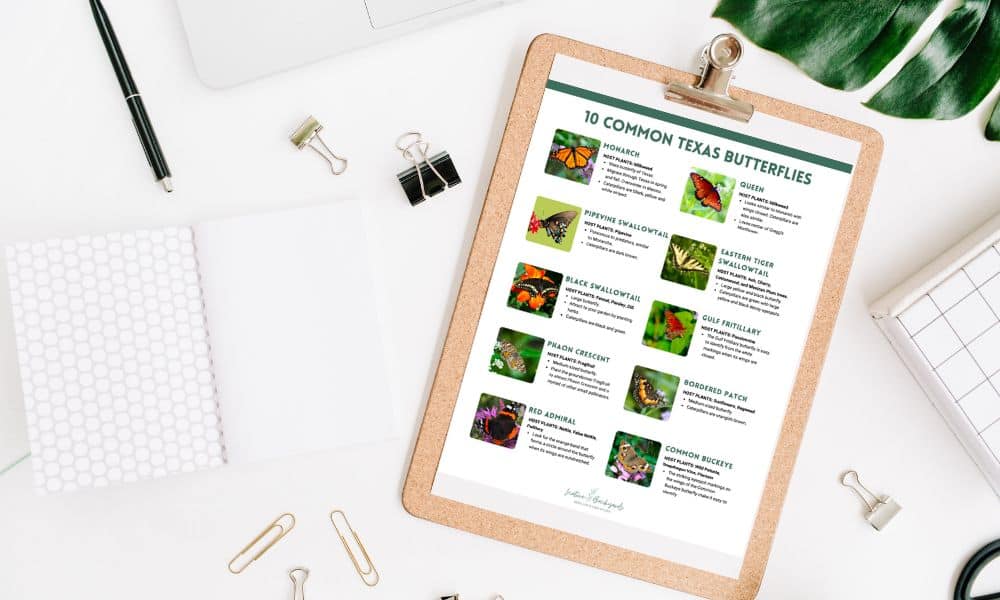
Texas Monarchs (and Look-Alikes!)
It’s always exciting to spot a Monarch in Texas. But take a closer look, and you may actually be seeing one of their look-alikes!
1. Monarch (Danaus plexippus)
Host plants: Milkweed
Did you know that the Monarch butterfly is the Texas state butterfly? This iconic orange butterfly is one of the easiest to identify while it travels through Texas.
In the spring, Texas is on the central path of the Monarch migration from Mexico north to southern Canada. Monarchs arrive just as their host plant, Milkweed, is starting to put on new growth.
The monarchs return in the fall on their long journey to their winter homes in central Mexico. Here in San Antonio their fall migration peak is typically the third week in October.
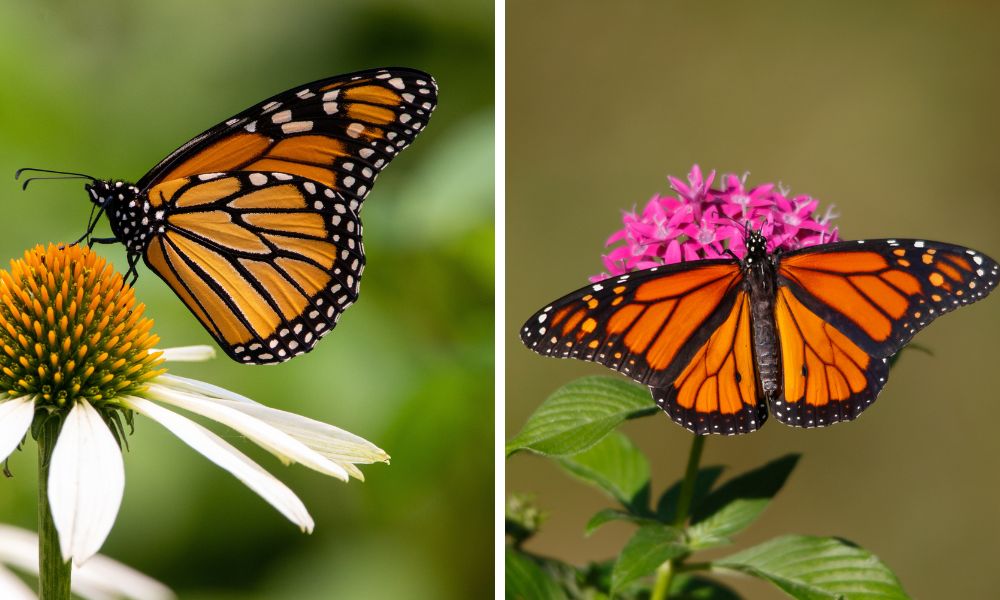
- Monarchs require Milkweed to survive! It is the only plant their caterpillars can eat.
- Whenever possible, avoid Tropical Milkweed (Asclepias curassavica), which is commonly sold at nurseries. Here is why.
- Instead, look for these native Texas Milkweed options at local nurseries that carry Texas natives:
- Antelope Horns Milkweed (Asclepias asperula)
- Butterfly Weed (Asclepias tuberosa)
- Texas Milkweed (Asclepias texana)
- Swamp Milkweed (Asclepias incarnata)
- Zizotes Milkweed (Asclepias oenotheroides)
2. Viceroy (Limenitis archippus)
Host plants: Willow, Cherry, and Poplar trees.
Viceroys are expert mimics! They look almost exactly like Monarch butterflies, but if you look closely there is an extra horizontal line that runs along their hind wings.
Some butterflies, like the Viceroy, have adapted to mimic more poisonous butterflies and trick predators. Monarchs are poisonous thanks to the compounds they digest from Milkweed.
If you want to attract Viceroy butterflies, plant their host trees! Trees are some of the best butterfly and moth host plants around.
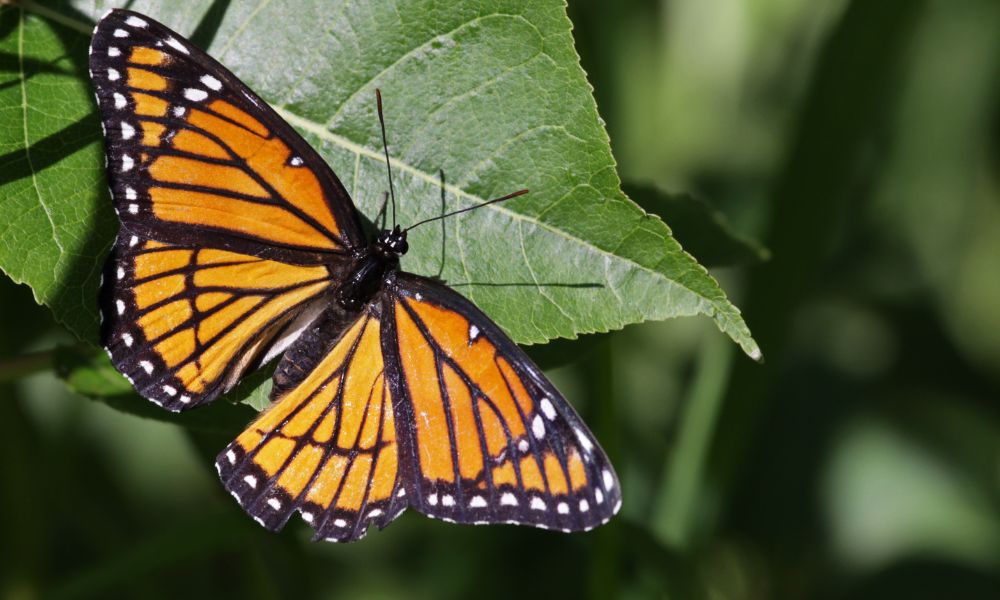
3. Queen (Danaus gilippus)
Host plants: Milkweed (the same host plant as Monarchs)
The Queen butterfly is one of the butterflies I see most often in San Antonio. Perched on a flower with its wings closed, it looks very similar to a Monarch. However when it opens its wings you will notice white spots, but not the black webbed lines Monarchs have.
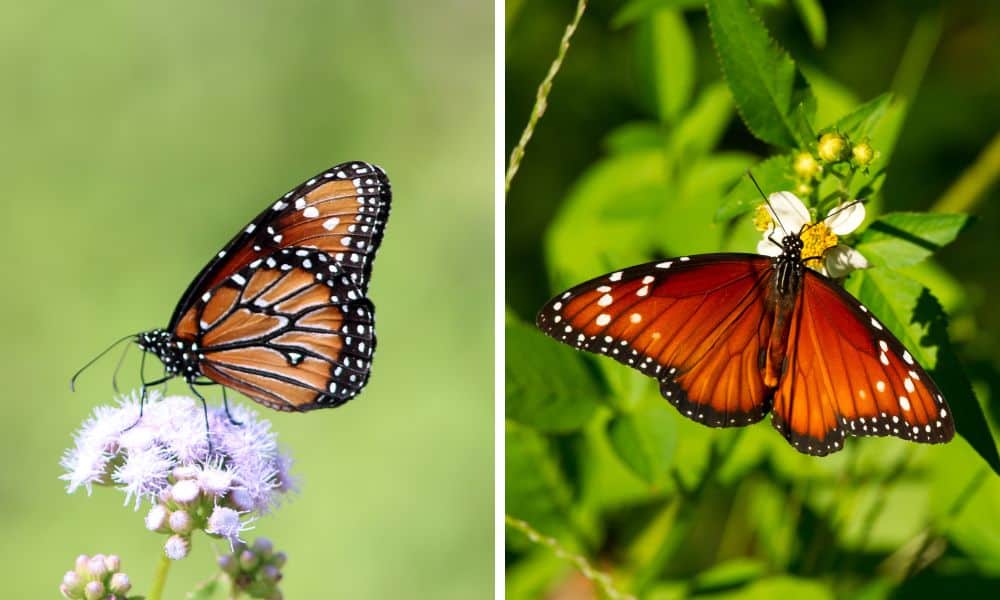
Queen caterpillars look very similar to Monarch caterpillars. The easiest way to tell them apart is to count their antennae-looking tubercles. The Monarch has two sets, while the Queen has three:
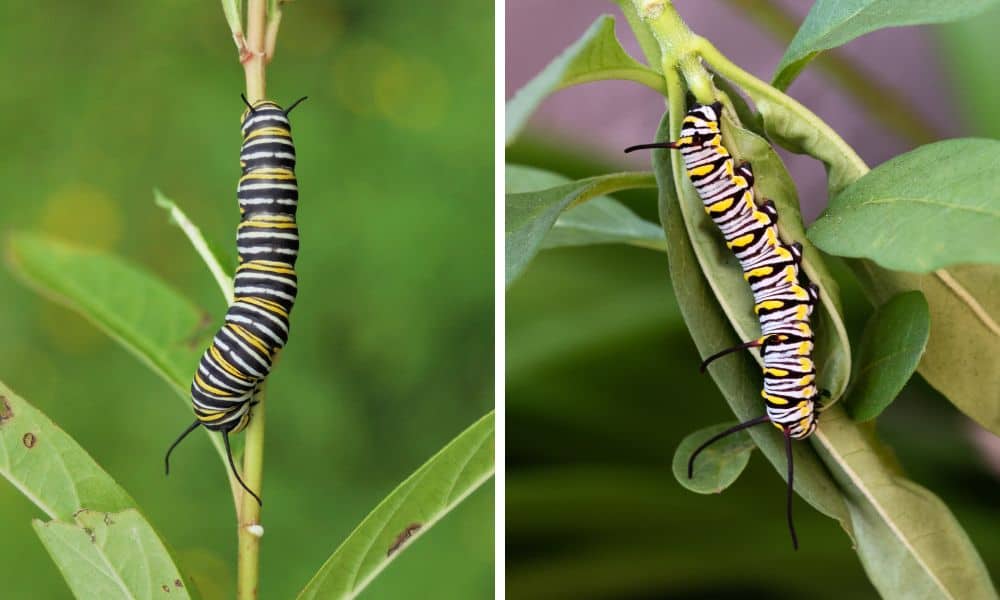
While Queen caterpillars eat Milkweed, the adults love the nectar of Gregg’s Mistflower. This plant will often be covered in Queens. It is a must for your butterfly garden!
Texas Swallowtails
After Monarch, Swallowtails are some of the easiest to recognize, and most beautiful, of butterflies! Here are a few of the Swallowtail butterflies you can find in Texas:
4. Pipevine Swallowtail (Battus philenor)
Host plants: Pipevines
Pipevine Swallowtails are one of the more common butterflies in Texas. Similar to Monarchs, they are poisonous to predators, thanks to toxins from their host plant, Pipevine. Other butterflies, such as the Red-Spotted Purple, mimic it.
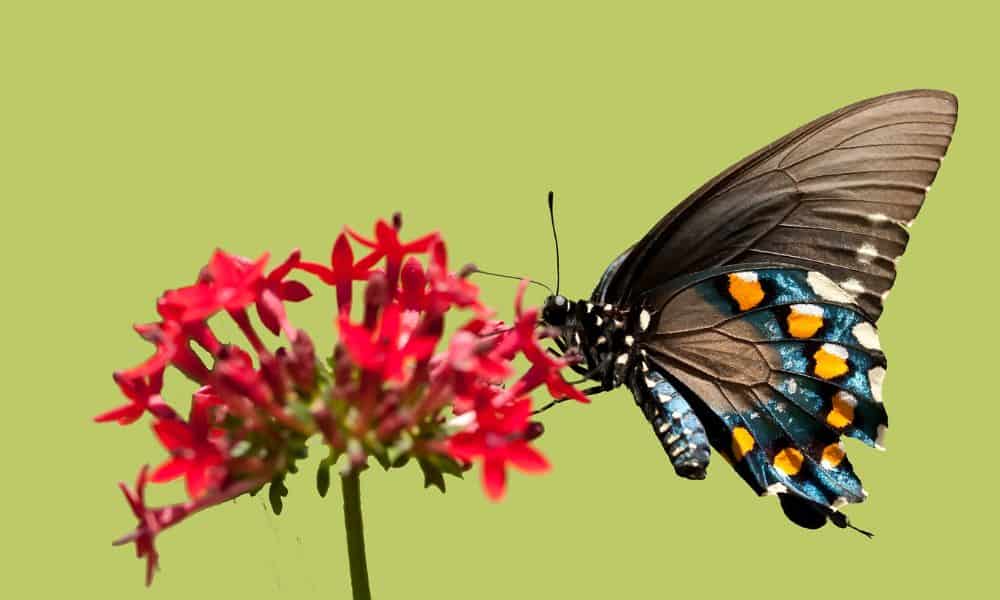
Pipevine Swallowtails have unique caterpillars to other Swallowtails. They are brownish-red and pokey looking!
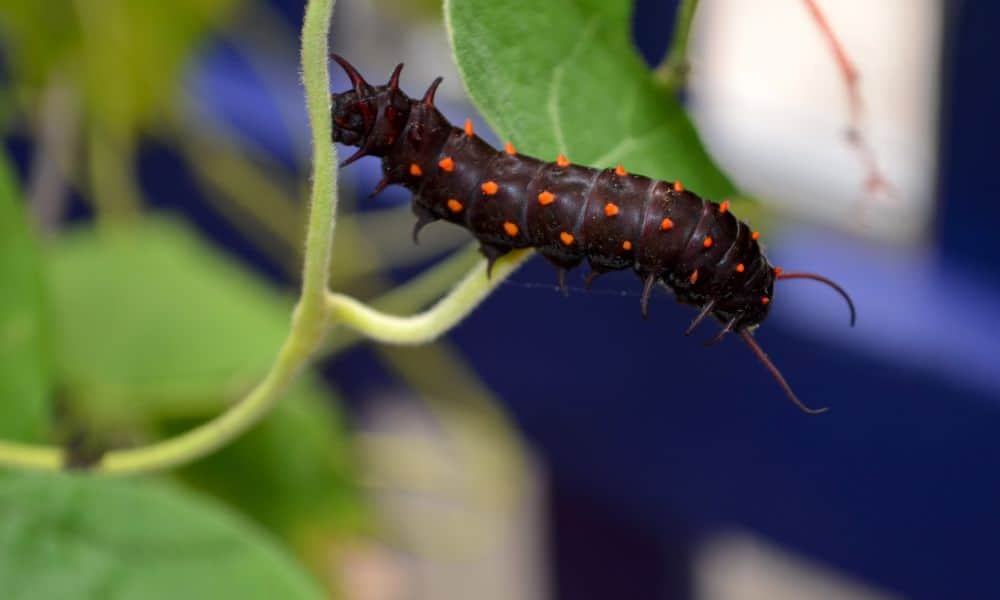
It can be hard to find Pipevine (Aristolochia species) at the nursery. Seek out a local nursery that specializes in natives and ask them to carry it. Or reach out to your local Native Plant Society. Their members may propagate some to share.
White-Veined Pipevine is a non-native Pipevine that some nurseries sell. It is a ground cover.
5. Eastern Tiger Swallowtail (Papilio glaucus)
Host plants: Ash, Cherry, Cottonwood, and Mexican Plum trees.
This beautiful black and yellow butterfly always gives me a sense of awe when it flutters by. You can’t help but notice the brilliant burst of yellow! It is found throughout Texas except for far West Texas and the Panhandle.
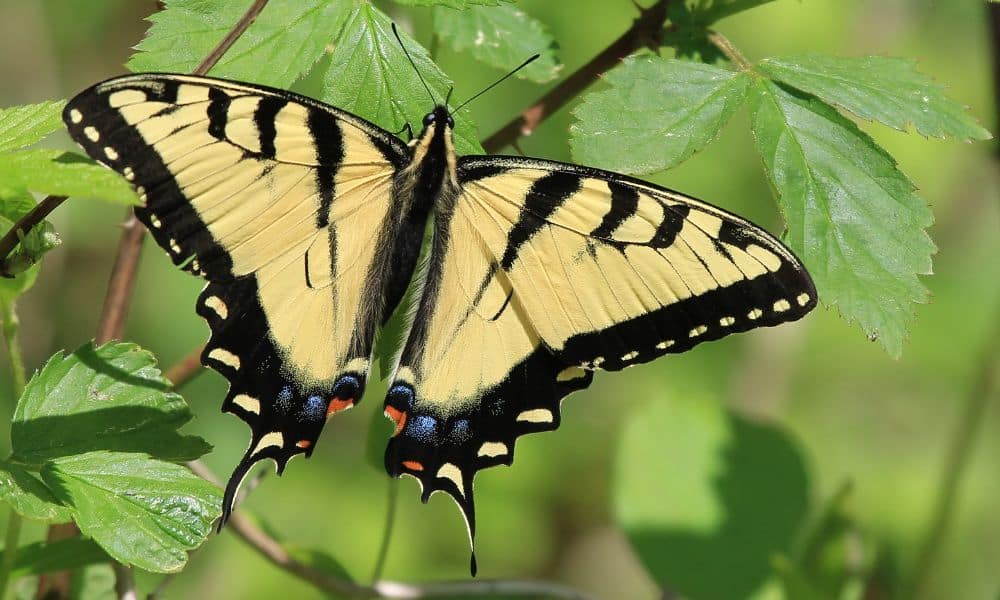
6. Giant Swallowtail (Papilio cresphontes)
Host plants: Prickly Ash and Wafer Ash trees, Citrus trees
The largest of the Swallowtail butterflies, it is also one of the largest butterfly species in North America. Its wingspan can be over 5 inches across! It is yellow and black like the Tiger Swallowtail, but with different markings.
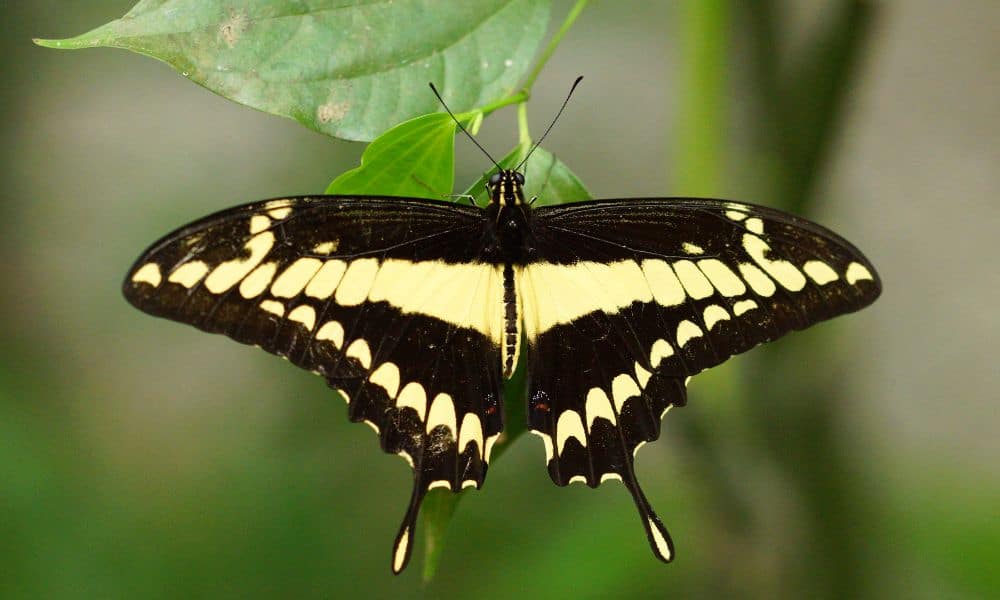
7. Spicebush Swallowtail (Papilio troilus)
Host plants: Spicebush and Sassafras
The Spicebush Swallowtail mimics the poisonous Pipevine Swallowtail in its coloring. However, you can identify it by the clear line of white circles running along the base of its wings.
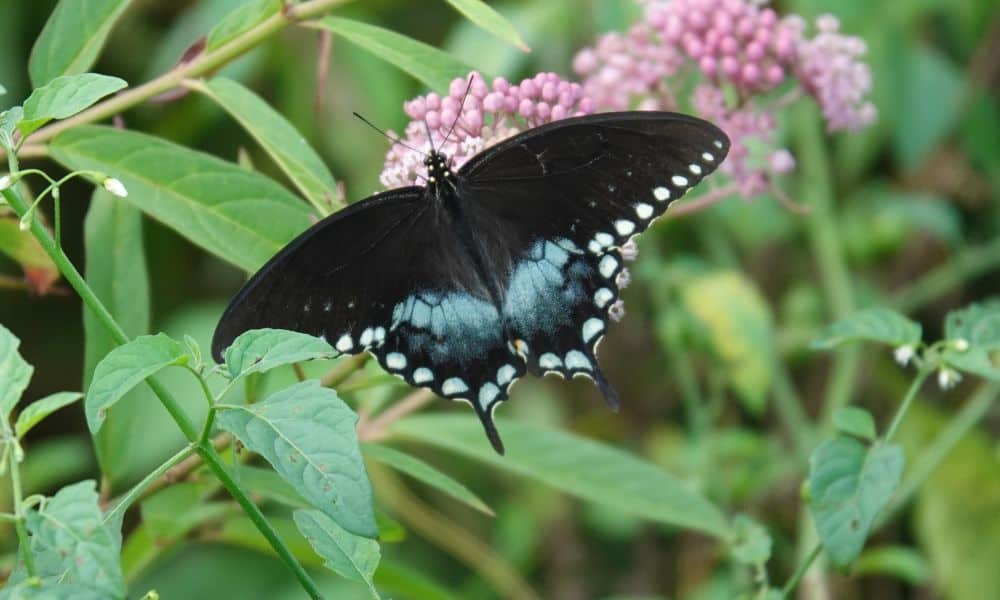
8. Black Swallowtail (Papilio polyxenes)
Host plants: Fennel, Parsley, Dill
Attract this beautiful butterfly to your yard by planting herbs in your garden! Their host plants are fennel, parsley, dill, and rue. The adults will lay their eggs on these plants and you’ll soon see caterpillars.
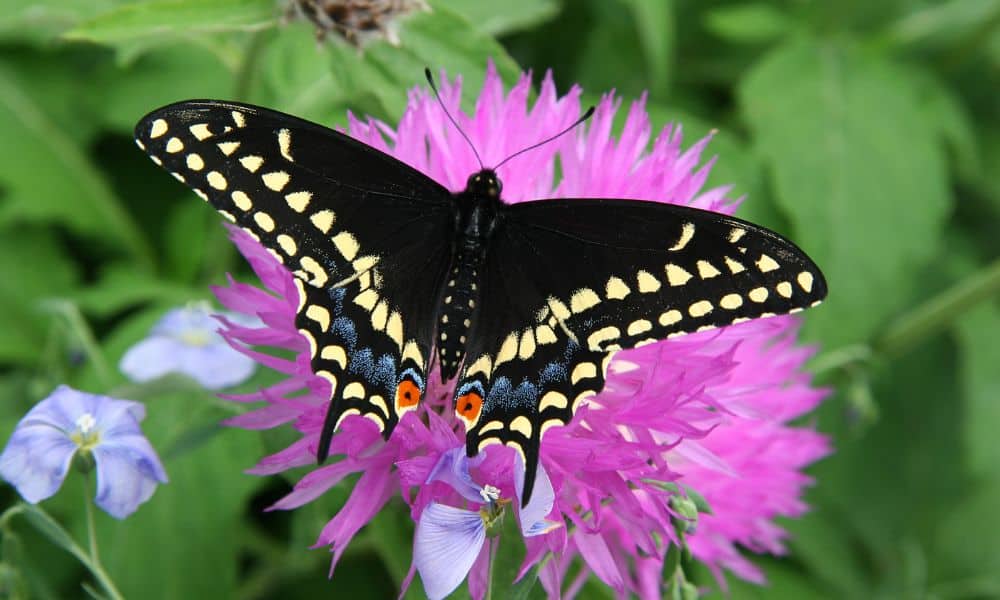
The Black Swallowtail caterpillars look quite different than other Swallowtail caterpillars. They are Black, white and green similar to Monarch caterpillars.
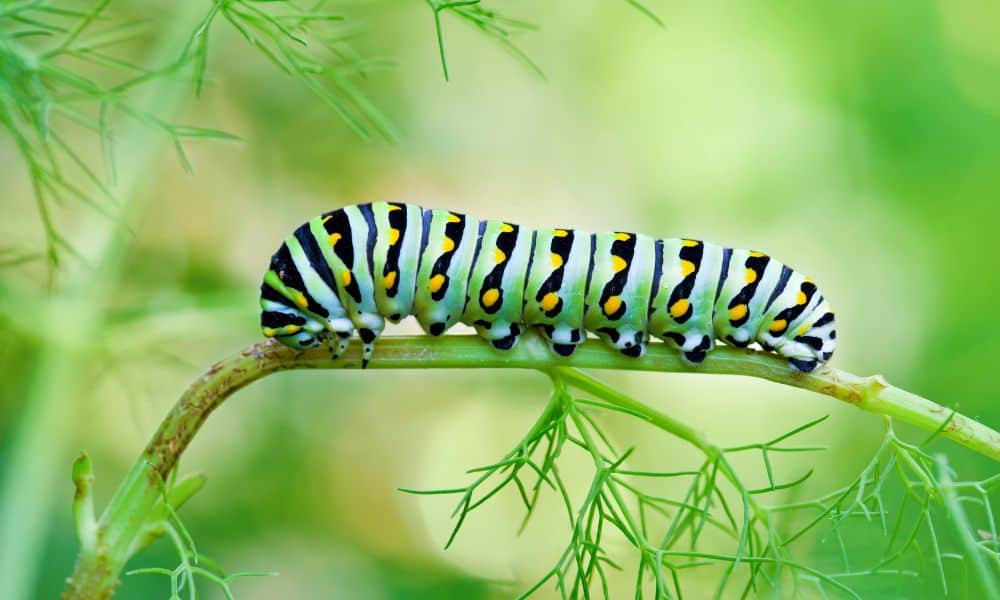
Texas Fritillaries
9. Gulf Fritillary (Agraulis vanillae)
Host plants: Passionvine (Passiflora species)
These orange and black butterflies are some of the most common butterflies in Texas. You can find Gulf Fritillaries wherever their host plant, Passionvine is growing. Look for native Texas species Passiflora incarnata to grow in your yard.
I have Passionvine growing in my yard and there will almost always be a female fluttering around it on a sunny day, laying its eggs.
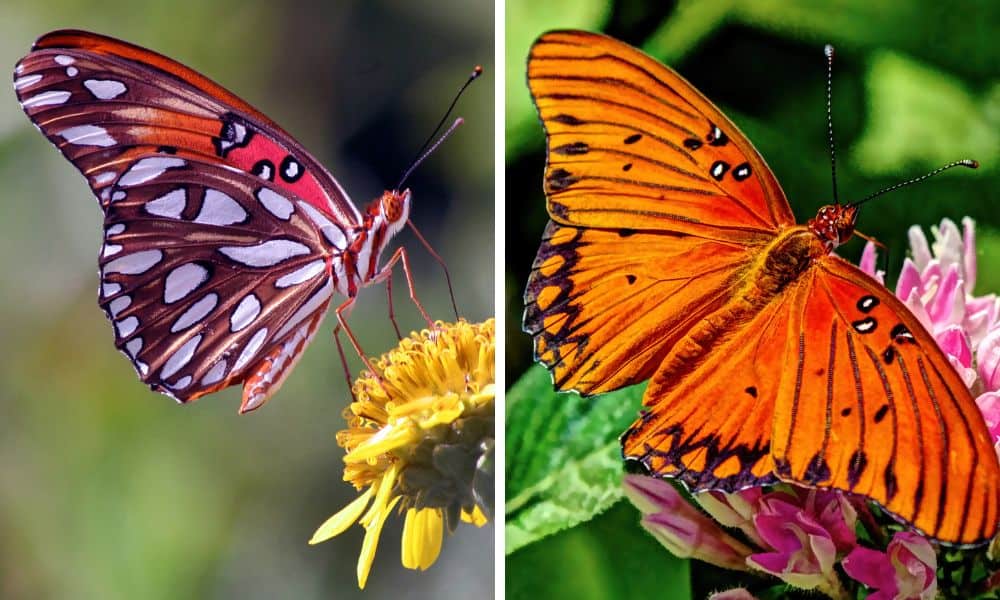
10. Variegated Fritillary (Euptoieta claudia)
Host plants: Flax, Passionvine, Purslane, Violets and Pansies
The Variegated Fritillary can be found flying all year in Texas. It has a variety of host plants including Passionvine. It is not a true Fritillary, but shares traits with Fritillaries and Longwing butterflies.
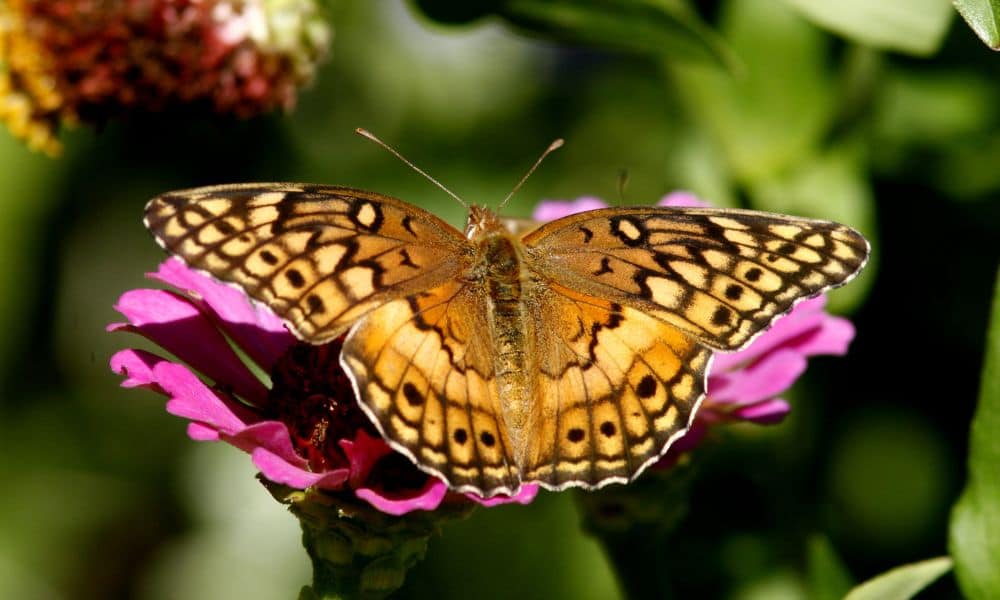
Texas Crescents
Crescent butterflies are smaller butterflies, with a wingspan typically no larger than 1.5″ across. These common backyard butterflies can be tricky to tell apart.
11. Texan Crescent (Phyciodes texana)
Host plants: Flame Acanthus, Wild Petunia, Water Willow
Texas Crescent butterflies are the only butterfly on this list named for our great state! These native butterflies have a range that spans westward from Texas to California.
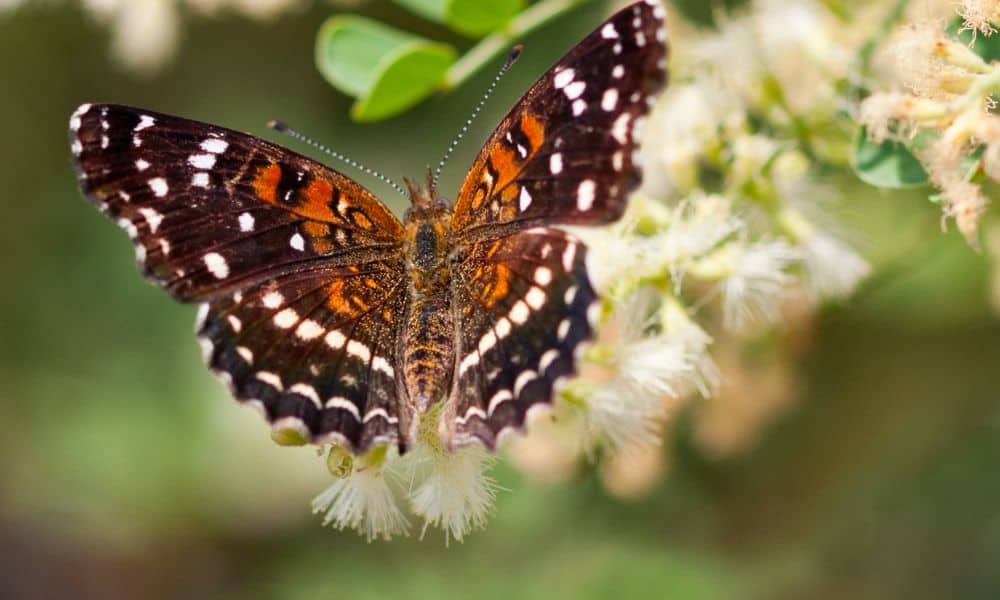
12. Phaon Crescent (Phyciodes phaon)
Host plants: Frogfruit
This little butterfly uses one of my favorite Texas native plants as its host plant – Frogfruit! Plant this pretty groundcover to attract Phaon Crescent and a myriad of other small pollinators.
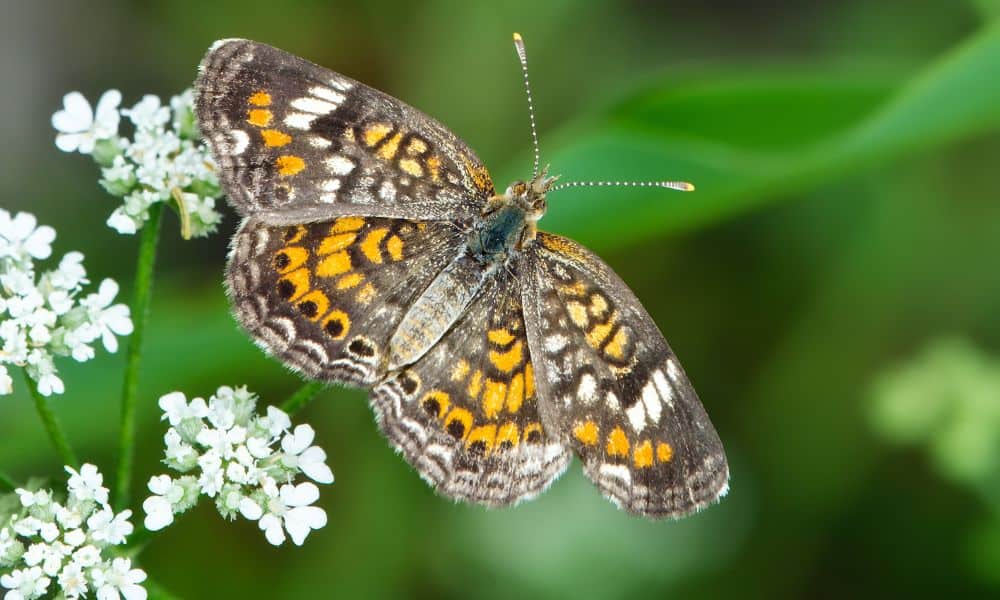
13. Pearl Crescent (Phyciodes tharos)
Host plants: Asters
The Pearl Crescent butterfly has more black markings around the edges of its wings than other Crescent butterflies.
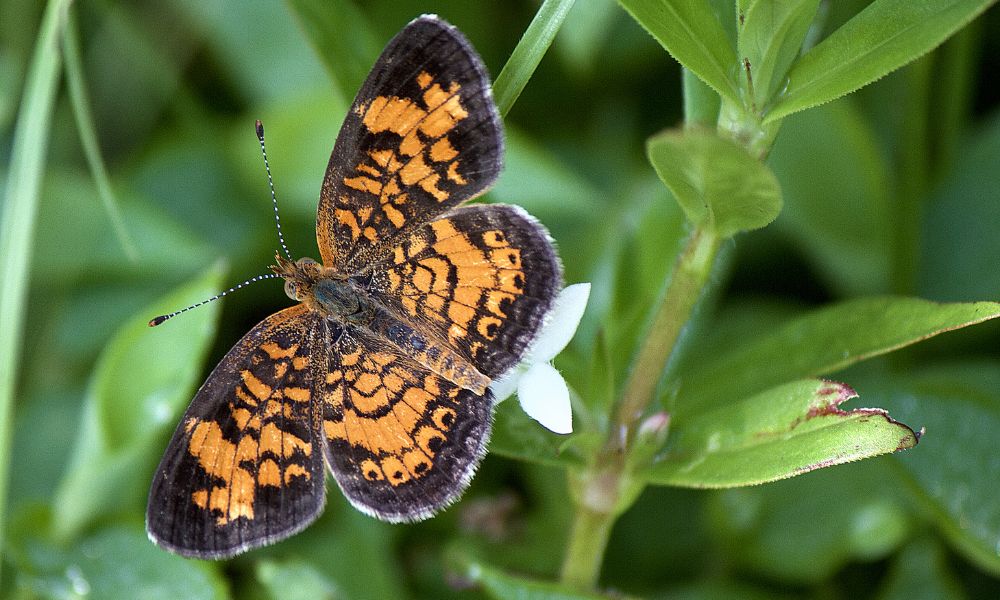
14. Vesta Crescent (Phyciodes vesta)
Host plants: Tube-tongue
The Vesta Crescent has a silly-sounding host plant: Tube-Tongue. This Texas native plant with purple flowers also goes by the scientific name Justicia. I recently spotted a Vesta Crescent nectaring on Shrubby Boneset. See the video here.
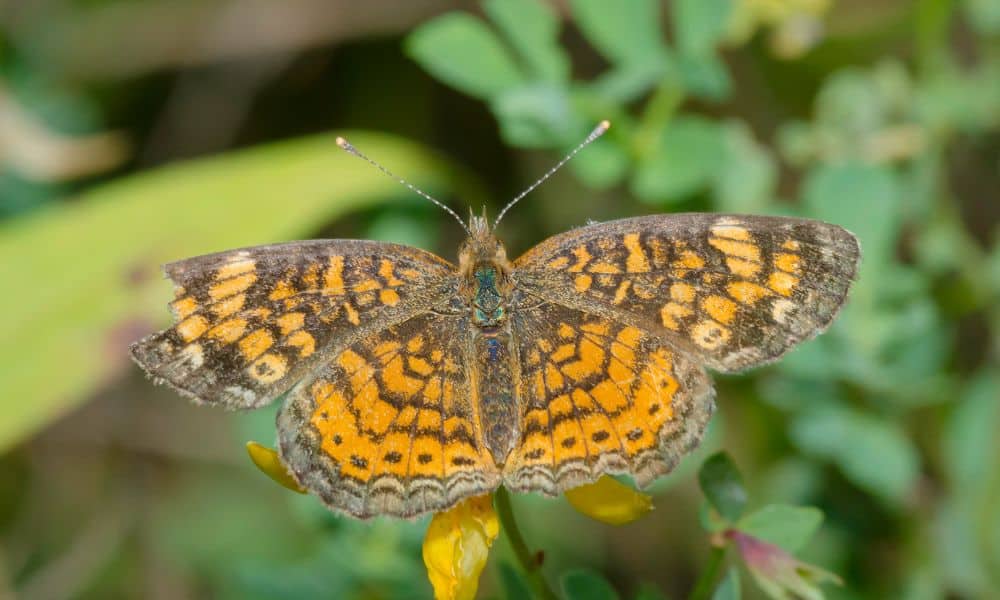
Other Common Butterflies in Texas
15. Bordered Patch (Chlosyne lacinia)
Host plants: Sunflowers, Ragweed
Plant Sunflowers and you can help support the pretty Bordered Patch butterfly. Sunflowers are their host plant along with Ragweed (which you probably don’t want to plant if you have allergies!).
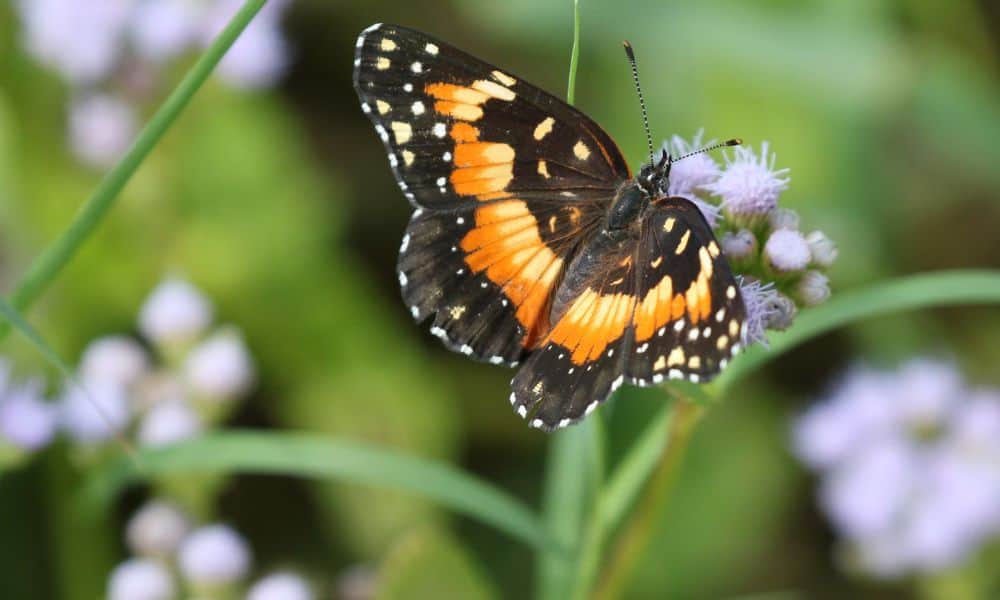
My Annual Sunflowers (Helianthus annuus) were covered in Bordered Patch caterpillars last summer. If you see caterpillars on your flowers, don’t try to get rid of them. First, identify them and learn about what they will become. Your flowers are playing an important ecosystem role! They will rebound from being eaten.
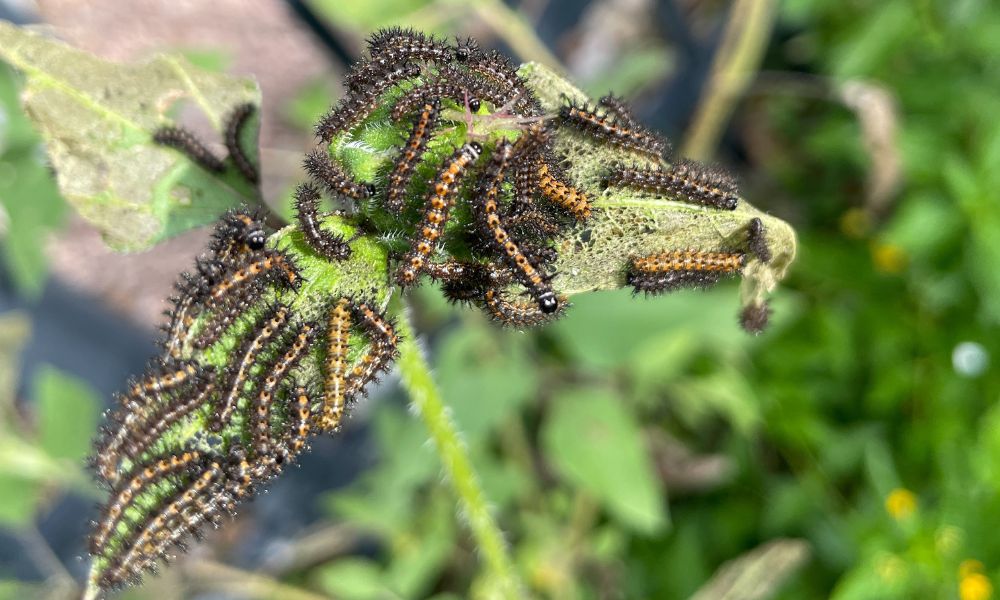
16. Red Admiral (Vanessa atalanta)
Host plants: Nettle, False Nettle, Pellitory
The unique coloring on the Red Admiral butterfly makes this one easy to spot. When it is resting with its wings outstretched, you’ll notice the orange band that forms a circle around the butterfly.
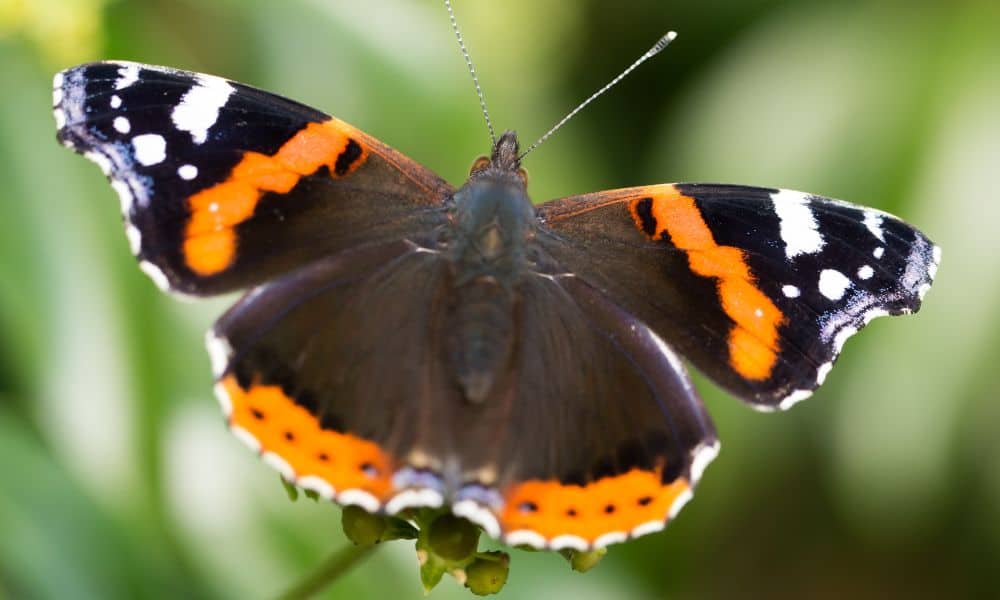
17. Common Buckeye (Junonia coenia)
Host plants: Wild Petunia, Snapdragon Vine, Plantain
The striking eyespot markings on the wings of the Common Buckeye butterfly make it easy to identify. Common Buckeyes are one of my favorite butterflies to spot! They are common throughout North America.
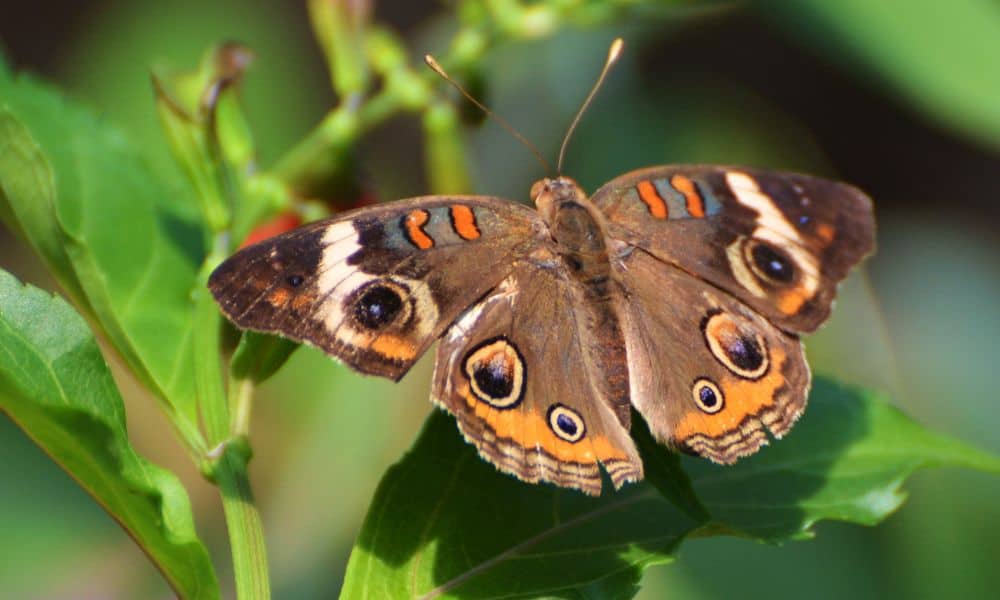
18. American Snout Butterfly (Libytheana carinenta)
Host plants: Hackberry trees
Large numbers of American Snout butterflies can be seen in San Antonio and throughout Bexar County where I live in early fall. They often are so thick they are hard to miss (and unfortunately can get squashed on your car!).
Each year’s emergence coincides with native hackberry trees putting on fresh growth. Snout Butterflies lay their eggs on new leaves so their caterpillars can eat them. There were even more Snout butterflies in San Antonio in 2022 than in past years, likely due to a period of drought followed by rainfall.
The Hackberry Emperor is another butterfly that uses Hackberry trees as its host plant.
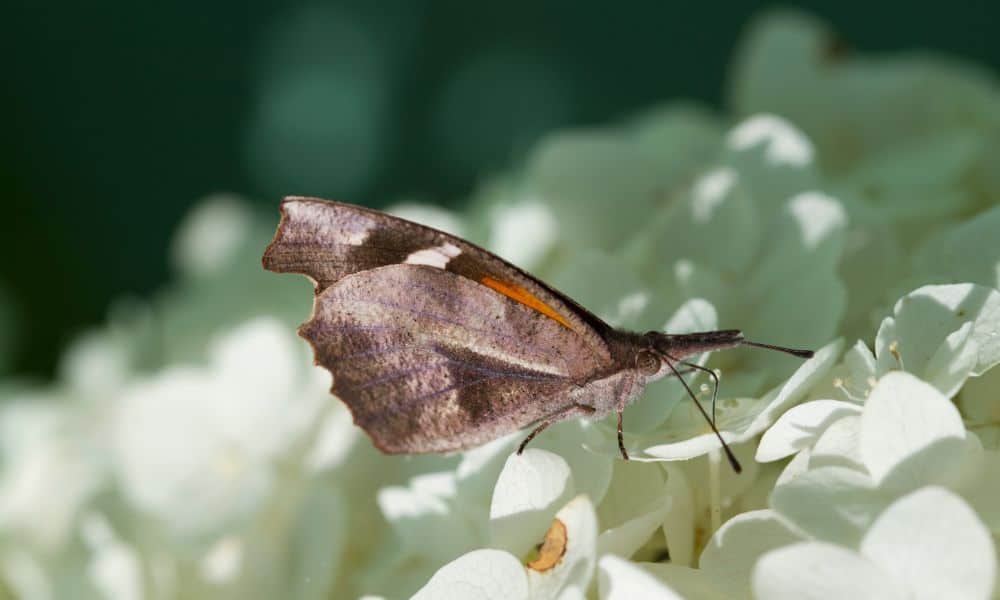
19. Southern Dogface (Zerene cesonia)
Host plants: Dalea, Clover, False Indigo, , Texas Kidneywood
This little yellow butterfly is one of several Sulphur butterflies common in Texas. You can identify this one by the black circle with a white center on its forewing. Look for this spot to avoid confusing it with other Sulphur butterflies such as the Cloudless Sulphur or Orange Sulphur.
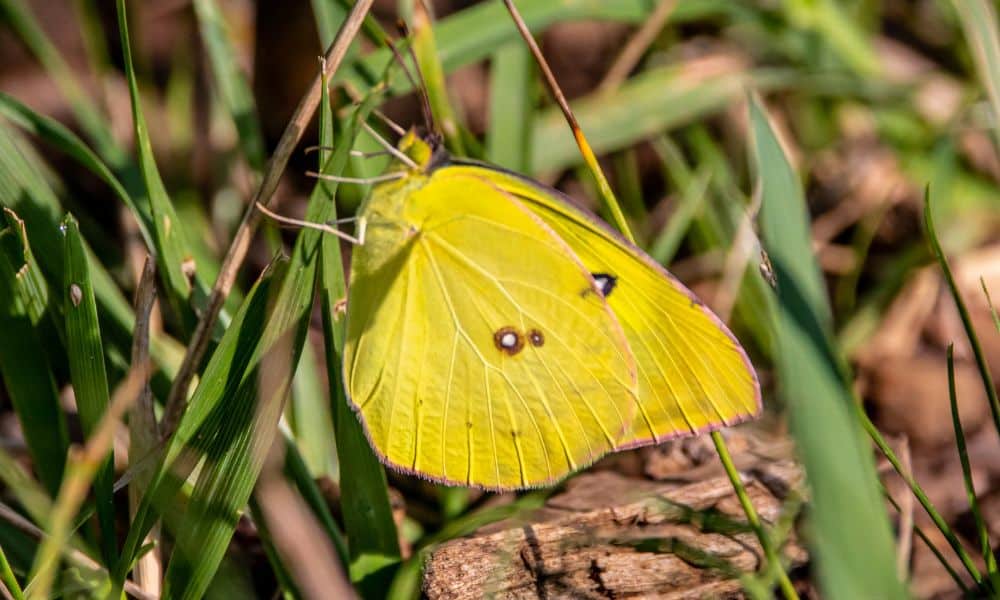
20. Gray Hairstreak (Strymon melinus)
Host plants: Mallow, Thistle, Texas Lantana, Clover, others
This small butterfly has a wingspan of about an inch. There are several different types of Hairstreaks in Texas, but this is the one I see most often. It uses up to 90 different plants as its host plant including Mallow, Thistle, Texas Lantana, and Clover.
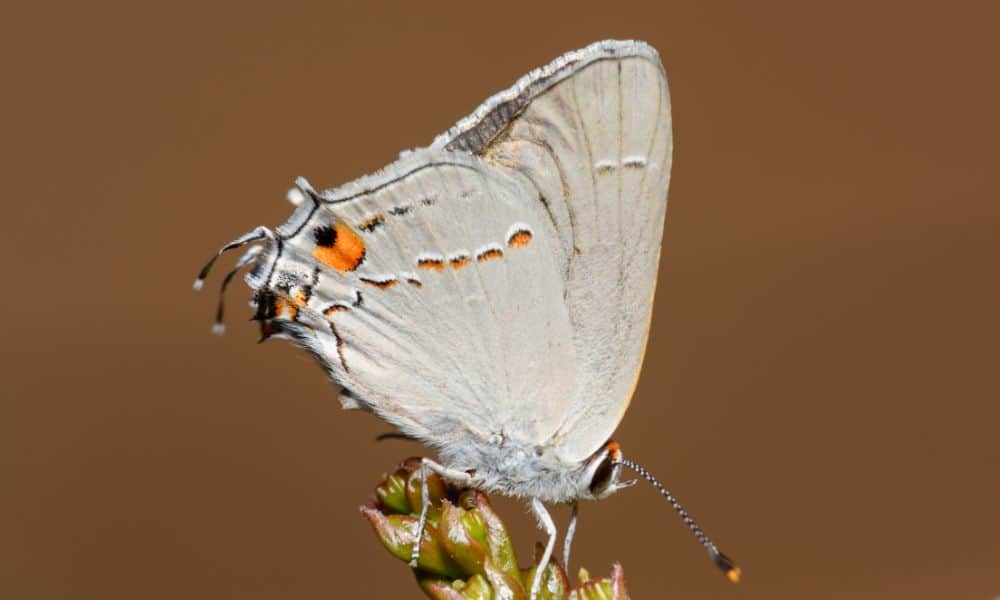
21. Question Mark (Polygonia interrogationis)
Host plants: Elm trees, Hackberry trees, Nettle, False Nettle
The uniquely-shaped wings of this butterfly make it a fun one to spot! It is very similar looking to the Eastern Comma butterfly, with slightly different markings on their hind wings.
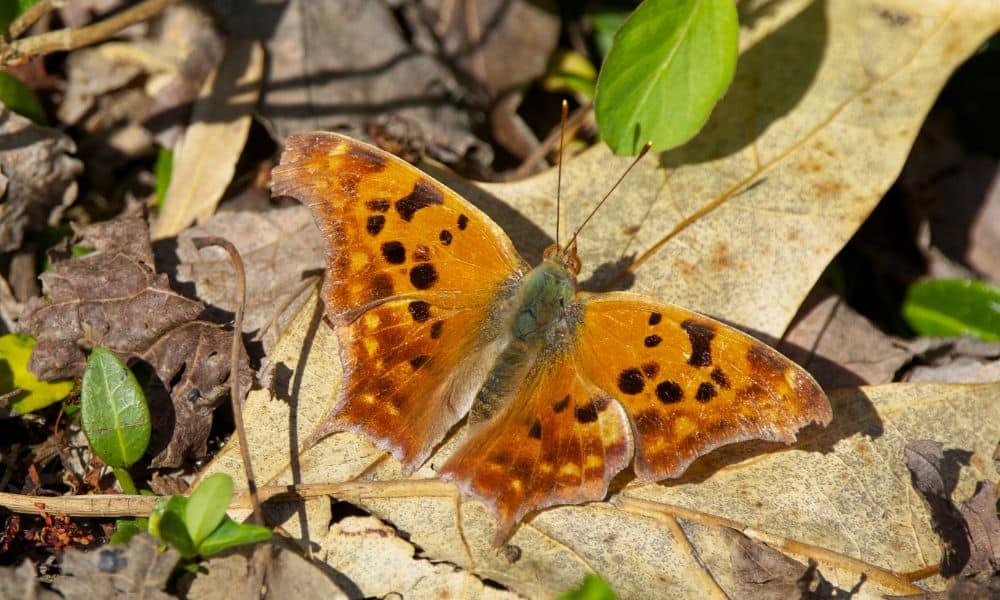
22. Painted Lady (Vanessa cardui)
Host plants: Thistle, Mallows, Legumes
The Painted Lady is one of the most common butterflies throughout the world! It uses a wide variety of plants as its host plant. The American Lady is another similar-looking butterfly of the same genus.
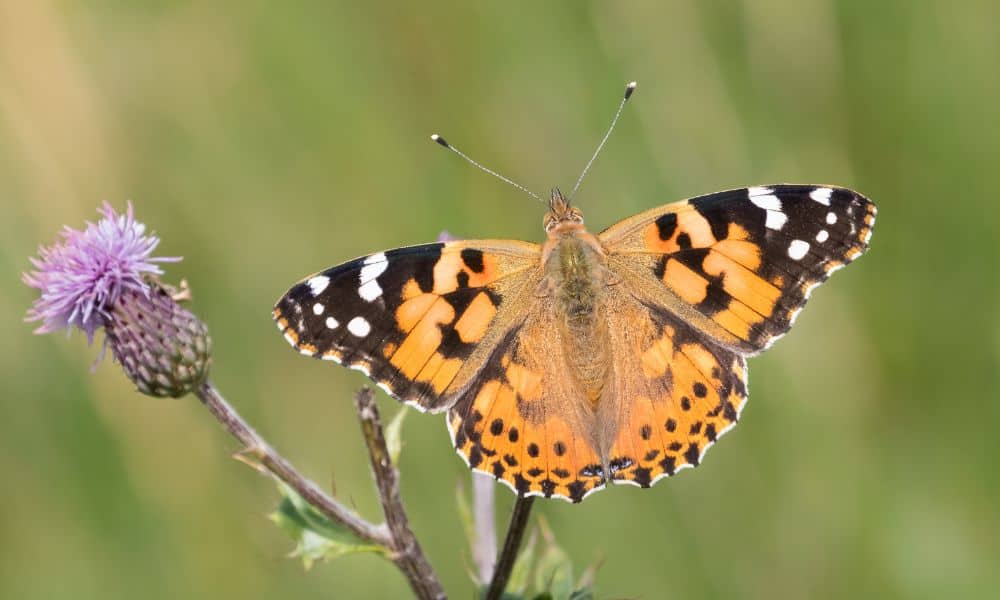
23. White Peacock (Anartia jatrophae)
Host plants: Frogfruit, Ruellia, Flame Acanthus
The White Peacock butterfly is easiest to spot in south Texas. Its host plant, Frog Fruit, is one of my favorite native groundcovers!
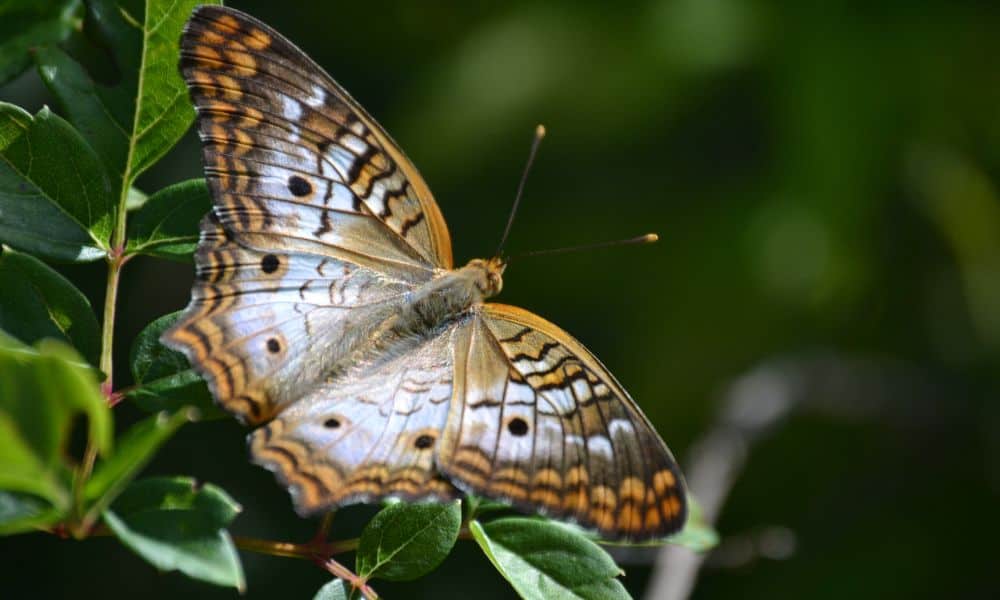
24. Fiery Skipper (Hylephila phyleus)
Host plants: Native Grasses, Bermuda Grass
Skippers are a special type of butterfly. They are a cross between a butterfly and a moth. Skippers use grasses as their host plants.
There are a number of different skippers in Texas, but the Fiery Skippers is one you will likely see nectaring on flowers such as Gregg’s Mistflower or Buttonbush.
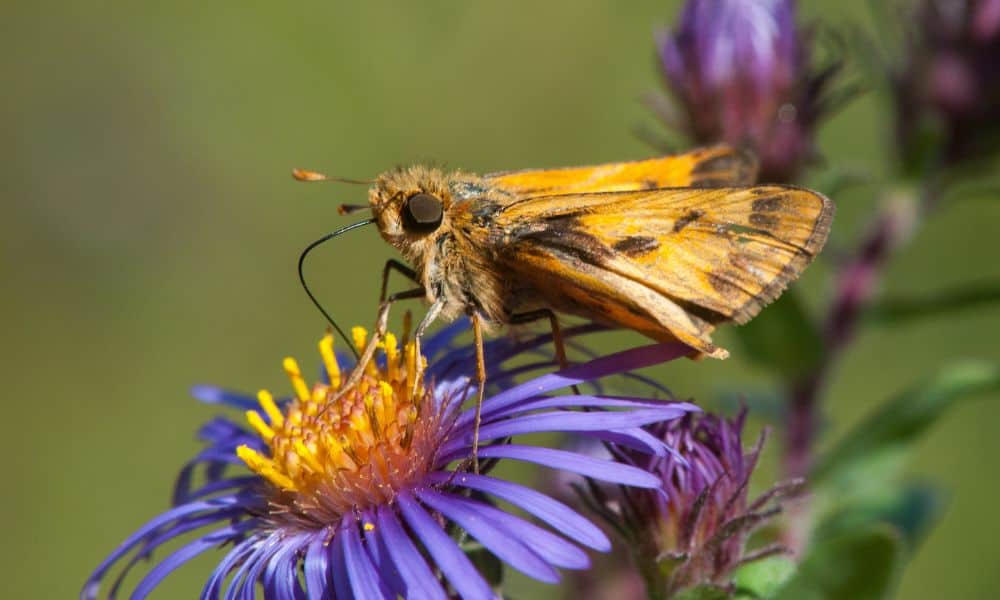
25. White-Striped Longtail (Chioides albofasciatus)
Host plants: Legume vines
The Longtail butterflies are a really fun one to spot because they look so unique. I often see them nectaring on Buttonbush (shown below). The image is a little blurry because they don’t like to stay still!
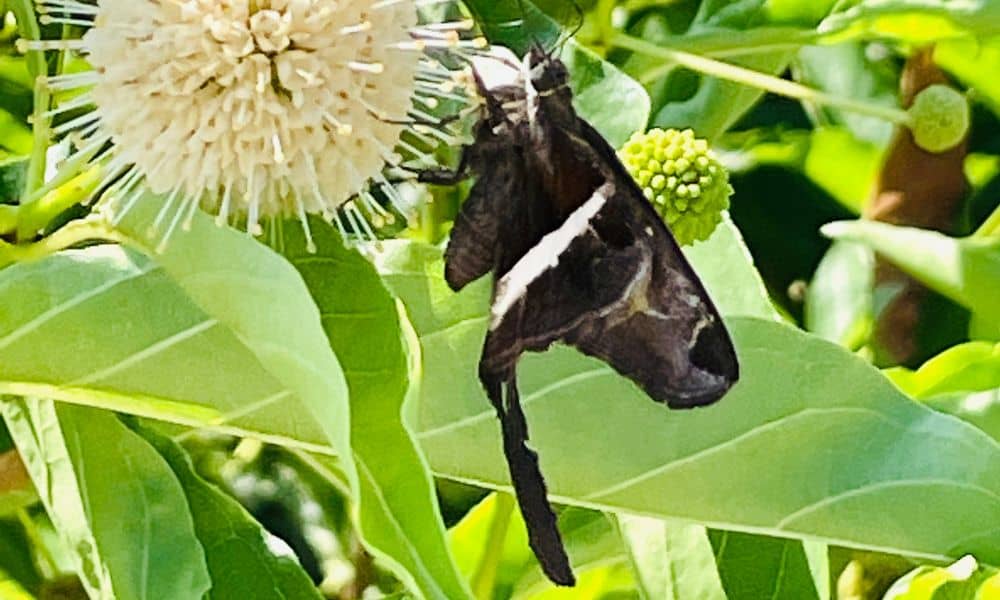
Texas Butterflies and Native Plants
The best way to create a butterfly garden? With plants that are native to your local area! These plants serve as host plants for our local butterflies. Adult butterflies lay eggs on the specific plants their caterpillars are adapted to eat.
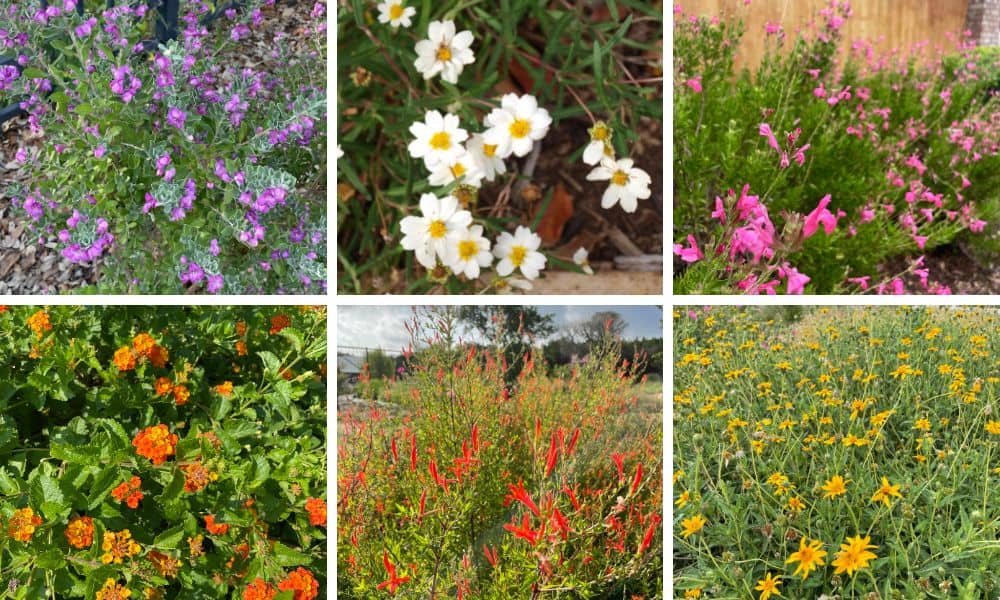
Urban development throughout Texas has caused significant habitat loss for butterflies and other insects. By planting butterfly host plants in our yards, we can start to rebuild some of that important natural habitat!
Here are some of recommendations for native plants that attract butterflies in Texas:
Create a Monarch Waystation by planting their host plant, Milkweed. Opt for native Texas Milkweed such as Antelope Horn Milkweed or Butterfly Weed. Include nectar plants as well. Butterflies are particularly drawn to native plants with clusters of flowers such as Gregg’s Mistflower or Frostweed.
Best Texas Butterfly Books
These laminated pocket guides are my favorite Texas butterfly resource to recommend! They are the first guide I bought once I started getting into identifying butterflies. Take these guides with you when you head to Texas parks or natural areas.
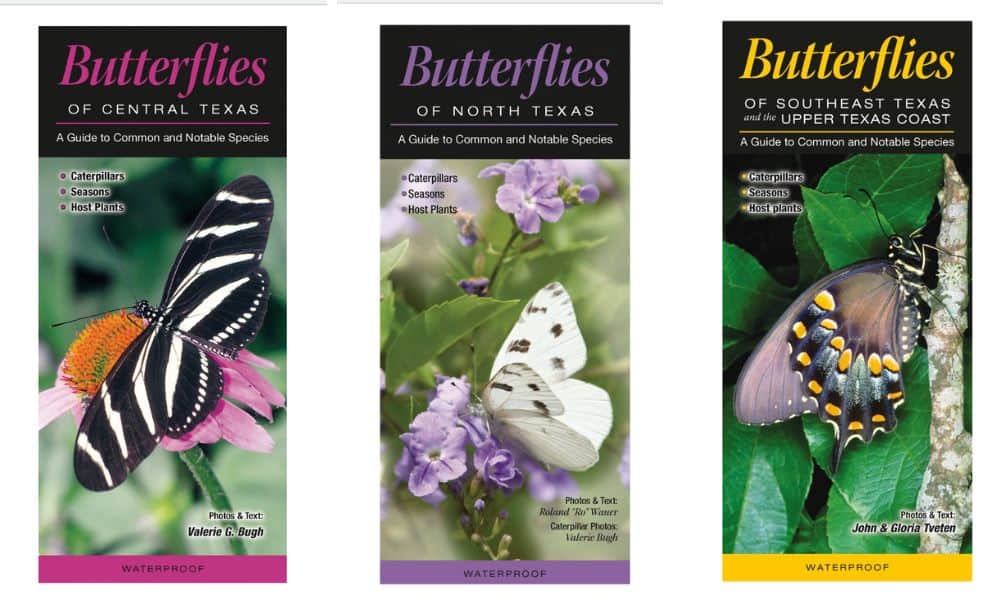
They are an accordion fold field guide with clear photos to help you quickly identify a butterfly. Choose one for your region of Texas:
- Butterflies of Central Texas
- Butterflies of North Texas
- Butterflies of Southeast Texas and Upper Texas Coast
These are my two favorite reference books about Texas butterflies:
- Native Host Plants for Texas – Plant an entire garden of Texas butterfly host plants with this helpful book. The authors recently published a companion book on host plants for Texas moths!
- Butterfly Gardening for Texas – This hefty book is the perfect coffee table resource. It provides a detailed overview of numerous Texas butterflies, native host plants and nectar plants, along with lots of butterfly gardening tips.
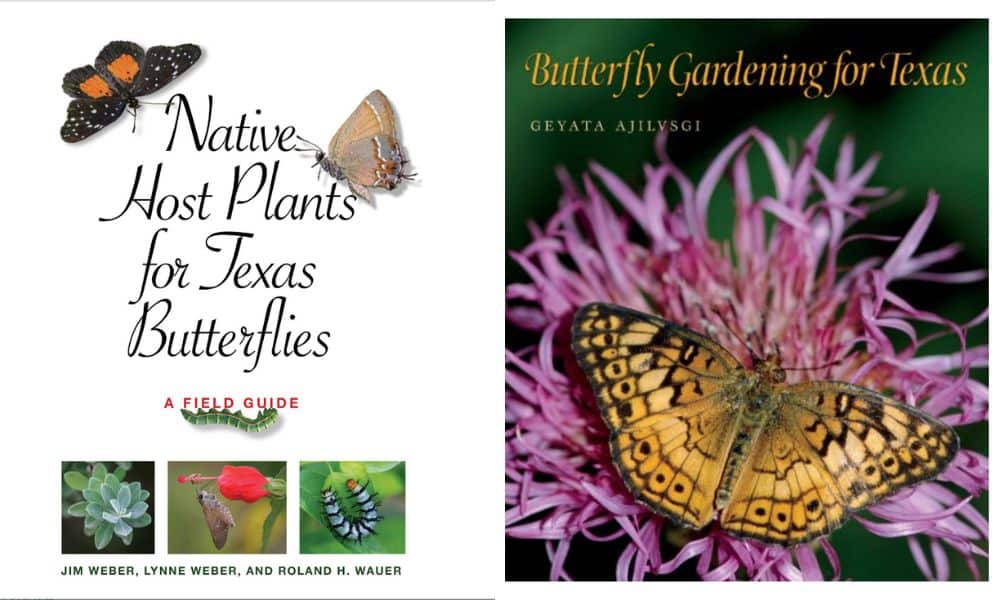
Have a Butterfly Garden? Get this Garden Sign!
Shop it here in the Native Backyards Etsy shop.
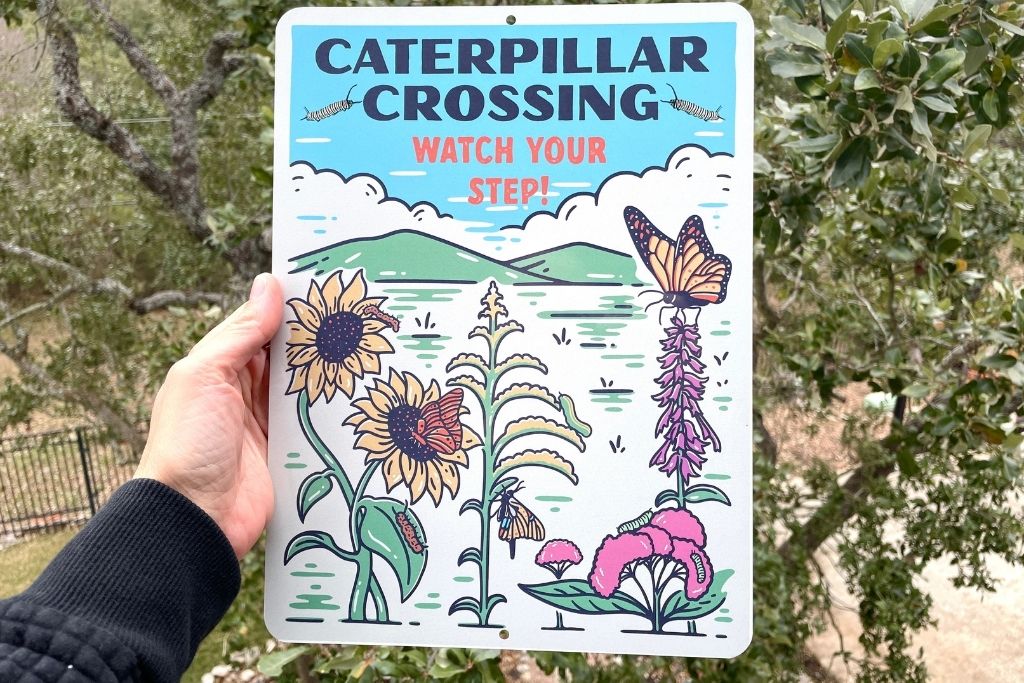
Learn About More Texas Insects and Wildlife!
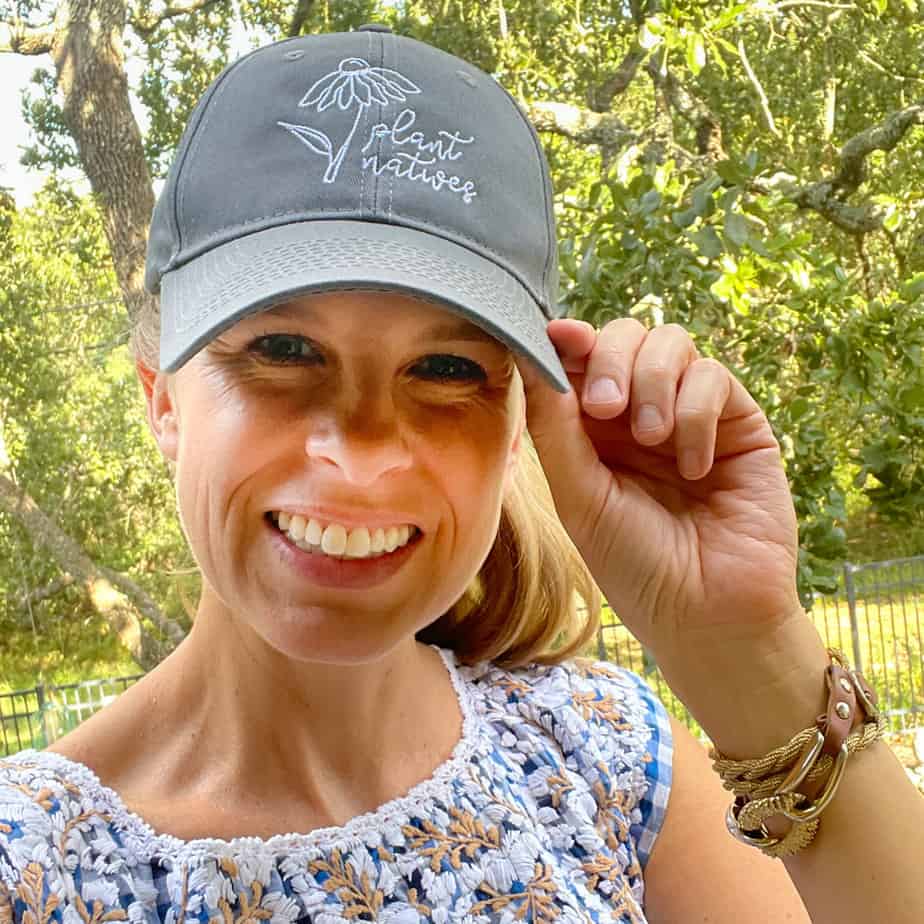
Welcome to Native Backyards! I’m Haeley from San Antonio, Texas, and I want to help you grow more native plants.
I have seen firsthand how the right plants can bring your yard to life with butterflies, bees, and birds. I’ve transformed my yard with Texas natives and I’m excited to share what I’ve learned with you.
Join my newsletter here! – each week I’ll send you helpful tips to make your native plant garden a reality!
Want to learn more about me and my garden? Check out my About page!

Hi Haeley, I really wanted to hear your presentation at Boerne NPSOT meeting last week but could not attend! Way to go!
Thanks Renee! I’m doing another one at Phil Hardberger on April 1st if you can make it!
Hi Haeley, This is a fantastic butterfly resource for Texas! It was a pretty good year for Monarchs and Gulf Fritillaries here in Galveston, and I also spotted Swallowtails, Crescents, Skippers, and others from your list. I also had a few that looked like Monarchs or Fritillaries, but turns out they were Queens! I’ll be planting many more of the host plants discussed in this article, and I’ve already shared your site with friends and neighbors as well as on my own social media sites, (Gulf Coast Gardener.) I look forward to reading more of your articles. Thanks Again!
Hi Link, Thanks so much for taking the time to leave a comment. I’m so happy that you found the resource helpful and you are sharing it with others. It sounds like you are well on your way to creating a butterfly haven in Galveston!